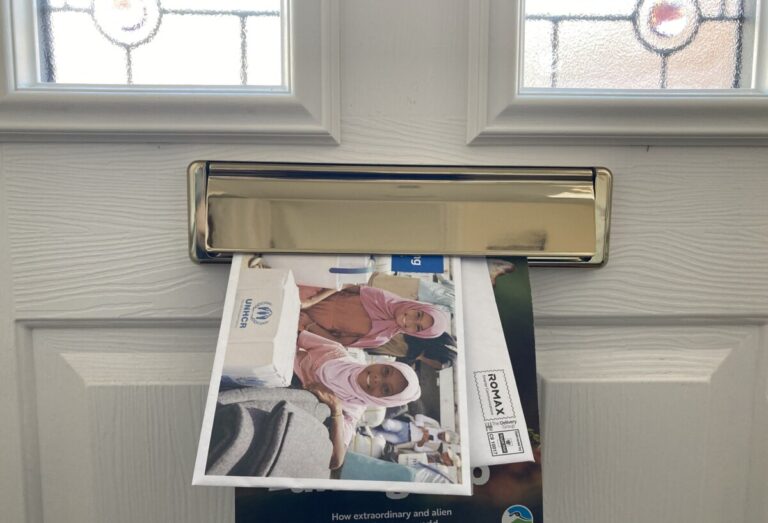Top tips for successful direct mail – from compliance to copy

Direct mail is a great way of engaging people. Not only does it provide the space to tell a story and tell it well through captivating words as well as pictures, but it’s something that people can – and do – hold on to, and share.
Philip Ricketts, Wholesale Commercial Director, Royal Mail comments:
“Mail remains a critical medium for charities in today’s fast paced omni-channel world. It allows charities to put a targeted personal message directly into the hands of their chosen audience. It offers charities an unmatched ability to tell their story and guide donors to engage further, whether that means going online for more information, making a donation via post, phone or online or strengthening donor relationships.”
Advertisement
But no one thing makes a direct mail campaign a success. Instead, like any channel activity, it’s the sum of its parts. While it of course mail has to grab people’s attention from the doormat, and tell a good story, it also has to reach the right audience in the first place, comply with data protection regulations to do so, go out (and arrive) at the right time, and be as environmentally friendly as possible.
Covering some of the key areas, 7 experts provide their top tips for making sure your campaign ticks the right boxes.

Data protection
Simon Blanchard, Partner, Data Protection Network Associates says:
To make sure your direct mail marketing complies with data protection laws, first you’ll need to decide on your lawful basis. You have a choice between relying on consent or legitimate interests.
Relying on consent
Consent means you give supporters a genuine choice about the types of communication they receive. People you’re targeting by direct mail must have actively opted-in to receive direct marketing by mail. Relying on this means you’ll need to make sure you exclude anyone who didn’t give that opt-in for mail, along with anyone who has since chosen to opt-out of it.
Relying on legitimate interests
Direct mail does not fall within the scope of the Privacy & Electronic Communications Regulations (PECR), so you may wish to rely on legitimate interests. You should conduct a Legitimate Interests Assessment (LIA) for your mailing activities. A key point to consider will be how you collected your supporters’ personal information. Did you:
- Notify them you wish to send fundraising communications by mail?
- Give them an opportunity to object, e.g. an opt-out box?
For each mailpack, be sure to provide a method for mail recipients to exercise their right to opt-out from further mailings.
The Mailing Preference Service (MPS)
This affects ‘cold’ mailings, i.e. where you have no existing relationship with those you are mailing. The Code of Fundraising Practice requires that you must not send marketing mailings to people who have registered with the MPS – IF you cannot show any evidence of a previous relationship with that person. So cold mailing lists must be screened against it.
We can’t cover everything in detail here, so for more information see the Code of Fundraising Practice, section 9.3 ‘Fundraising by mail’, which also covers enclosures within the mailpack.

Data
Suzanne Lewis, Managing Director, Arc Data says:
If you’re running a cold direct mail campaign, getting the data selection right is crucial. Three key areas to consider before you hit the button are the ‘why’ behind the campaign, the file mix you’re sending to, and your target response rate.
Understanding the why is critical to ensuring a mailing only goes to those it’s relevant for. A one-off mailing with a specific message to existing supporters will require a smaller, very specific mailing universe than if it’s the first of a broader series, while if you want to talk to a new and different group of people, this might mean looking for data from a different region or age group.
In terms of mailing file mix, some lists give average performance but good volume, while more niche files tend to give a high response rate or higher average donation with lower volume. Generally, you need a blend of both, with the mix depending on objectives and how you’ll be measuring success. How many records you take from each file will also vary, depending on whether they’re high or low performing.
You may also want to check which data sets have tended to give at least a second donation in the past and to look for something similar. Sometimes those lower responding at the outset ultimately have a better lifetime value. This is where it can be worth bringing in specialist expertise to guide your selections.
And it’s worth remembering that to reach your target response rate, say that’s 2%, not every mailing file needs to perform at this level. It’s more important to get the mix right – choosing some with known performance levels both above and below your target response rate means you will achieve the mailing volume you need for the overall campaign to reach your target.


Delivery considerations
Lance Hill, Managing Director, Eight Days a Week and Gemma Mitchell, Director of Postal Service, Paragon Customer Communications, Board members of The Strategic Mail Partnership say:
Postage costs are a significant part of any DM campaign, but by designing a pack that can be efficiently processed by Royal Mail, mailmark services can be accessed offering lower unit rates. This can then be coupled with an economy service providing a staggered fall to earth and a 7% lower postage access price. Engaging with your printer and mailing house during campaign concept and design will help ensure the pack format is efficient both in terms of paper and production, and postage, ensuring you get the most from your budget.
A clear call to action will increase and drive engagement; simple changes like including a QR code provide supporters with a quick and easy way to respond or donate, and a simple change like this, incorporating technology, can be incentivised by Royal Mail.
There are several current Royal Mail incentives available, so if you are looking to maintain or grow volume, or test and innovate your current mail campaigns there are numerous postage incentives that can provide 15-25% postage credits. Your mailing house or Marketreach can support you with these.
As well as encouraging supporters to continue to donate, acquisition activity is also a vital pillar in a communication strategy. Partially Addressed Mail by Royal Mail allows you to reach new customers without buying marketing lists. It’s a precise acquisition tool, allowing targeting at full postcode level, typically around 15 households, whilst also accessing a lower unit postage rate.
Mail’s strengths lie in building engagement and relationships; tapping into your print, mailing house and postal providers’ knowledge as early as possible in campaign planning will help to minimise costs and maximise on ROI.

Keeping it green
Jason Clough, Managing Director, Propack says:
There are lots of strands to consider when making your direct mail environmentally friendly.
Whether you are managing your mail internally or working with a provider, it is vital to look at all aspects of the process to ensure sustainable practices are being adopted at every stage. At Propack, we use water-based inks and machinery that doesn’t emit ozone to minimise our environmental impact at every stage.
Consider things like mail volume – do you really need as much as you are generating or would a print-on-demand solution be more effective, both in terms of cost and environmental impact?
Reviewing your processes, from design to delivery will help you to understand where there is room for environmental improvements. Asking questions such as ‘is my paper supply sustainable?’, ‘are my mailers recyclable?’ and ‘are we, and our partners, treating supply chains fairly?’ are great starting points to take action.
At Propack, we launched our postage brand Ethical Mail® five years ago to ensure that as well as adopting sustainable practices within our factory, we were consistently delivering that, even when a piece of mail has left our hands.
Most recently we have partnered with climate positive experts, Ecologi, to further solidify our commitment to sustainable practices by offsetting all of the carbon associated with the delivery of our mail.
I encourage charities to really dig deep into the processes that your providers are using, aligning yourself with a direct mailer who supports and drives your environmental goals is vital to a successful sustainable strategy.

Creative
Andy Powell, Creative Director, GOOD Agency says:
The book’s always better than the film, right? Where you create the world, protagonists and emotions in your mind.
Direct mail is the best of all worlds.
Create worlds in people’s homes. With stories of hope, powerful truths and urgent frontline updates. But don’t act like an uninvited guest – badgering punters before they’ve had their first coffee and cornflakes.
Connection is everything.
We use a system called CADABRA to turn doormat drama into packs that pack a punch.
- Connection
- Ask
- Dramatisation
- Ask
- Benefit
- Recap
- Ask
Without that initial connection, the rest is irrelevant.
Your envelope must be more compelling than the postal pile.
The first letter line must hook your reader in.
You must talk like a human, not a dry organisation.
CADABRA ensures you connect quickly, show why your story matters, give an emotive reason for a gift or sign-up, recap simply and reiterate your call to action. All using the essential fundraising framework of urgent, tangible and emotive.
Creativity in all directions
Even with a formula for success, direct mail lets you push the envelope.
- New sizes and shapes for standout
- Formats and folds that emphasise your story
- Inks and inclusions to create surprise and delight
Direct mail stays in homes for a week on average, is read multiple times and by more than just the recipient.
No wonder it has response rates that other channels dream of.
P.S.
Use bold, underline and bullet points to make your copy skimmable. And never forget a P.S. – the bit that people often read first.

Storytelling
Nayyar Mughal, Associate Creative Director, Open says:
A charity direct mail pack is largely made up of rules of three. First there’s the format: generally a letter, donation form and lift device. Then the content: demonstrating the problem, solution and the impact. And then the people involved: the charity, the beneficiaries and the target audience.
Lots of threes to think about. And when it comes to writing your direct mail pack, there are three truths that will lead you to authentic, engaging storytelling:
Your storyteller matters
Who you choose to be the voice of your story is just as important as the story you’re telling. If it’s an appeal for medical research, the most passionate voices will be researchers – and the patients who have benefited from research. If it’s emergency response, choose the responders witnessing it firsthand.
Powerful stories are personal stories
You have your storyteller, now let them tell their story their way. Try not to over edit or it will start to sound generic. People respond to people so make it sounds like it’s from a real person, not an organisation.
Your audience wants a simple solution
While many of the problems we raise money for these days are increasingly complex, the solution doesn’t have to be. Your audience needs to know what they can do, right here, right now. They can fund research. They can send food. They can be an ally. Give them a clear, simple role within your story, and they will respond.

Response handling
Scott Gray, Chief Commercial Officer (Charity Division), Mosaic Fulfilment Solutions says:
Speed and accuracy are key to your campaign response handling, and to your future supporter relationships. This means designing a response mechanism that enables both quick and easy response from your supporters, as well as the most efficient processing once it’s returned. Try to keep forms as simple as possible, minimise questions and include prefilled details like names and addresses that will mean less bother for your responder and will increase your results.
Consider using a unique identification 2D barcode or QR code on your forms so they can be machine scanned and collated into your CRM system fast and efficiently. The faster you can analyse campaign results and performance, the quicker you can turnaround your Thank You and any follow up communications while the response is still front of mind with your supporters.
When it comes to response forms and pack layouts, there are optimal templates that have been well tested, ask your DM partner for advice on what will work best for your pack. And think about your pack outer, roll-fold envelopes maybe an attractive cheaper option but they are harder to open in automated machines, slowing down the whole process.
Top tips for ensuring it runs smoothly:
- Time – supply forecasting of your DM campaigns to your response handling partners at least 6 months in advance; allow enough time to brief in new campaigns and for providing mailing files.
- Bespoke – consider any different / bespoke requirements to your campaign. This may take longer to setup and may require changes to response handling if additional data is being captured.
- Thanking – personalised thanking works well and can be configured in so many ways, for example, print-on-demand enables you to make personalised thank yous to each donor that are relevant and genuine.
- End to end testing – if you are trying a new process, make sure you factor in testing, it’s boring but essential!




